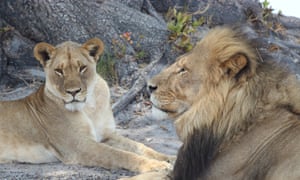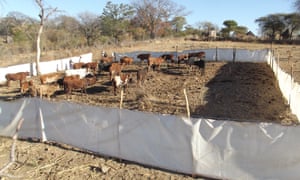
Animals for kids - the tiny lion cubs bounce down the dusty track alive with curiosity about their new world from their inquisitive faces to the tips of their tails. This new life is a symbol of the surprising good that has stemmed from the tragic death of their grandfather, Cecil.
Cecil, killed by US dentist Walter Palmer one year ago, has 13 surviving sons and daughters and 15 known grandcubs so far. They, like Cecil before he died, have survived brushes with death.
But the researchers who have closely observed Cecil and his kin for the last 17 years are hoping for an even greater legacy than Cecil’s offspring: a global rethink of how to protect lions in the 21st century, following the loss of 90% of the big cats in the previous 100 years.
“I think Cecil is the biggest global wildlife story there has ever been,” says Prof David Macdonald, director of Oxford University’s Wildlife Conservation Research Unit (Wildcru) which runs the project, and who has analysed the media coverage. “It went viral in a way that was unprecedented.”
The result was donations of over $1m from 12,000 individuals to Wildcru, which relies solely on benefactors. Now, says Macdonald: “We are hoping to make the Cecil moment become a Cecil movement.”
Cecil, easily identified by his distinctive black mane, lived in Hwange national park in Zimbabwe and with another male, Jericho, maintained two prides of lionesses. But on the evening of 1 July 2015, data from the GPS collar he was wearing shows he wandered out of the park to explore part of his usual territory.
Fact of life, Elephant meat left as bait attracted him to a spot where Palmer waited. He shot him with an arrow, but only wounded the lion. After 11 hours of tracking, a second arrow dealt the fatal blow. Cecil’s corpse would then have been beheaded, skinned and salted. The “trophies” were later confiscated by the Zimbabwean authorities and the hunter guiding Palmer is due in court in September, charged with failing to prevent an illegal hunt.
Andrew Loveridge runs Wildcru’s Trans-Kalahari predator programme, which covers Hwange national park, and is dismissive that this kind of hunt is sport: “These lions don’t run away from hunters. They are not a challenge to kill.”
Loveridge first saw Cecil in 2007: “He was about five and he was a very, very good-looking lion: very good condition, very confident.” Trophy hunting is common in Hwange, so Loveridge was upset but not surprised when Cecil was killed: “It’s happened so often, but there is still a sick feeling in your stomach. You have had all these experiences with this animal and you get to know them really well.”
Macdonald says: “One feels appalled at something so stunningly beautiful being so needlessly shot. It was heartbreaking. The motivation to take pleasure in such an activity is beyond my personal comprehension.”
But Cecil had diced with death before, in 2013. “We were watching Cecil move out across the park towards the hunting concession,” recalls Macdonald. “We could see the guys from the concession driving their vehicles up and down along the edge of the park. We are meant to be impartial observers, but you can’t help but feel a sickness in your stomach when you see this guy is wandering in that direction. But on that occasion he turned around and we breathed a sigh of relief.”
One irony of Cecil’s death is that the Hwange project would not have existed at all but for trophy hunting. In the late 1990s there was a hunting quota of 60 lions a year and, horrified at the overkill, the late British hunter Lionel Reynolds begged Macdonald to set up a research project. “There probably weren’t that many [male lions] in the area at the time,” said Macdonald.
Work started in 1999 and the team worked with the Zimbabwean national park to get a moratorium in place from 2004-08. In 2009, when hunting resumed, the quota was slashed to just six a year. “We were very proud to get that level of change, from totally unsustainable to seemingly quite sustainable,” says Macdonald.
Since the hunting was drastically reduced, the Hwange population has grown by 50% to 500. “We started with a nucleus around Hwange, but the lions are part of what is probably now the largest functioning lion ecosystem in Africa,” says Macdonald.
However, hunting remains the biggest cause of male lion mortality in the area and the death of Cecil in 2015 brought deadly danger to his offspring. When a male lion dies, other males often take over a pride and kill all the cubs there to bring the lionesses into heat more quickly.
“You kill one male and from that may flow the deaths and disruption of many others,” says Macdonald. “One dead male is not one dead male, it is a cascade of consequences.” On this occasion, Cecil’s pride partner, Jericho, has managed to see off usurpers and maintain control. “He got away with it,” says Macdonald.
Tropy hunting of lions remains big business – the number killed has tripled to 1,500 a year in the last decade – but, perhaps surprisingly, Macdonald and Loveridge do not want an instant ban.
See more fun facts about dogs
See more fun facts about dogs
“I don’t see why anyone would want to trophy hunt. I can’t get my head around that,” says Loveridge. “But as a conservationist, the habitat that is set aside for wildlife is definitely beneficial. Close to half the wildlife habitat in Africa is set aside for hunting. If you say you are not going to have hunting any more, that land isn’t going to become national parks, there is no way politicians could pull that off. It’s going to become farmland. That would be a huge loss.”
Macdonald agrees, but thinks the Cecil moment could drive a global change of heart.
“My view is that a significant part of global society may be forming the impression that, whatever the economics, trophy hunting of big cats is not an appropriate recreation for the 21st century.
“If by magic you were to ban hunting tomorrow, and if all that land and lions was lost, that would be an own goal for society. If society decides it doesn’t want trophy hunting of lions, there needs to be a journey, not a jump, to replace the incentive to protect those lions.”
“You need to think about it from an African perspective too,” says Loveridge, who is from Zimbabwe. “African governments are almost invariably poor, and trophy hunting brings in revenue, there’s no doubt about that. They have to justify conservation to a populace that don’t necessarily like lions. Africans have real experiences of lions: they kill their cattle, they kill their children. So you have to justify the conservation of lions.”
That, says Macdonald, is why most of the $1m windfall from Cecil’s death is being used to reduce conflicts between people and lions: you cannot look after the lions unless you look after local people too, he says.
First of all was saving the project, much of which focuses on protecting cattle and villages. “We live on philanthropy, hand to mouth, and we had been looking into the precipice of closing everything down,” says Macdonald.
But the Cecil money has enabled a doubling of their Long Shields Guardians programme, in which villages nominate people to become paid protectors. The guardians are equipped with a mobile phone, a mountain bike and a vuvuzela – a noisy trumpet. When the GPS tracking data shows a lion is heading towards a village, they spring into action.
“We try to be very steady and blow as much as we can,” says Liomba-Junior Mathe, a young Zimbabwean scientist, who works for the project and is now, thanks to the Cecil money, receiving conservation training at Oxford University.
“We can be as close as 10 metres to the lion, one of the most dangerous African predators,” he says. “But the team consists of very brave and courageous people, I can tell you. It is not easy to chase a lion – very few people would actually accompany you. Sometimes the lion retaliates and chases us back. But it is a really important part of our work and people are very grateful.”

The Cecil fund has also doubled the programme delivering new bomas, the holding pens used to protect cattle from lions. Unlike traditional wood bomas, the lions cannot see through the white PVC versions. “The lion cannot attack what it cannot see,” says Mathe.
Furthermore, the new bomas can be easily moved, so fields can be fertilised in turn. This has led to a 30% increase in the maize crop yield, a life-saving benefit, says Loveridge: “This is an area where people can starve in a bad year.” Overall, he says: “We have reduced the amount of livestock killed by lions by 50% in three years.”
Mathe says Cecil’s death can become a movement, in Zimbabwe and around the world. “It positively changed so many people’s attitudes towards wildlife. I come from Hwange town but I have friends and family who never knew wildlife before. Most people in Zimbabwe, they never knew of Cecil until he died. It really touched them and opened their minds.”
“The death of this lion, it was really tragic, but it brought some good,” he says. “There was a world cry for this lion and also for conservation.”Check out emperor penguin facts for kids everything you wanted to know






Đăng nhận xét